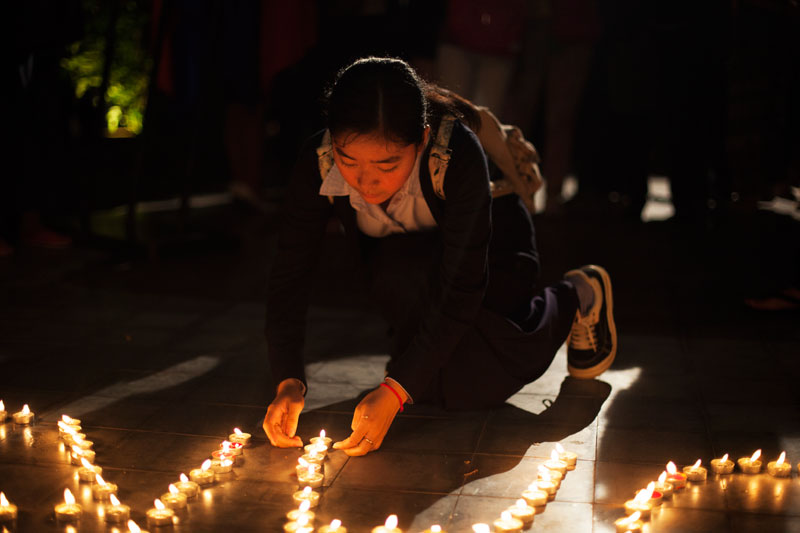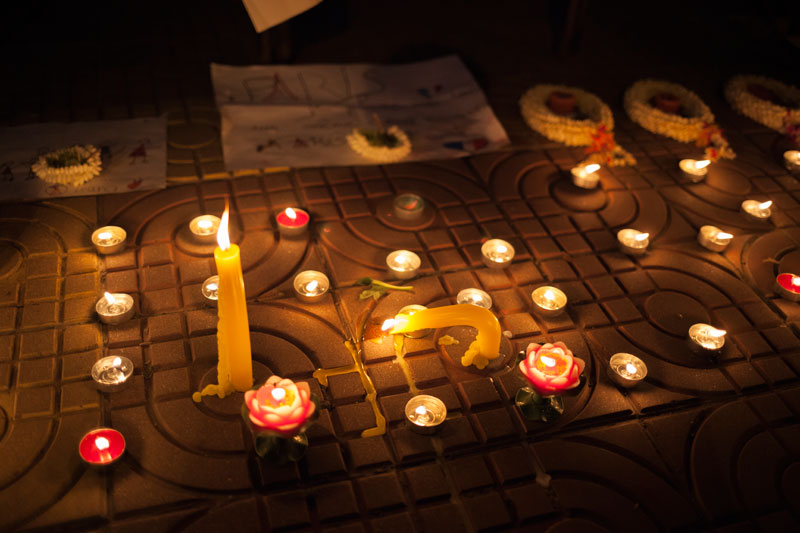It was Friday night and Parisians were out in the 10th arrondissement, a once gritty, working-class immigrant district now home to a lively cafe and bar scene.
Across from popular bar Le Carillon, Le Petit Cambodge was serving bowls of rice noodles and curry to its young, urban clientele. Set into a corner, the restaurant’s curved patio welcomed those chattering over drinks in the crisp autumn air.

Then the shots rang out. On the night of November 13, 14 people died when gunmen opened fire on the restaurant and bar.
A string of terrorist attacks that night—which also hit the nearby Bataclan concert hall, a stadium and other streetside locales—left at least 132 dead and hundreds injured. Extremist group Islamic State claimed responsibility for the attacks.
No Cambodians were killed. But the shock deeply affected the Cambodian diaspora in France, which is home to an estimated 80,000 people of Cambodian descent, according to the French Embassy.
Here in Cambodia, many also mourned. A memorial service for the victims, held at the Institut Francais in Phnom Penh on Tuesday, drew about 400 people, including some Cambodians who have lived in France or have relatives there. Candles forming the word “solidarite” lit up under the French flag as the crowd sang the French national anthem, “La Marseillaise.”
A French protectorate between 1863 and 1953, Cambodia has continued to enjoy an intimate relationship with the colonial power. Cambodians began migrating to France during that period, with some serving in the French armed forces. Many stayed on as Cambodia was torn by the Khmer Rouge in the 1970s, and more poured in as refugees from the civil war that followed the regime’s fall.
“I always say that I have two cultures: I have a French culture and a Cambodian culture. And with what happened in France, I am very, very affected,” said Prince Sisowath Tesso, who grew up in Paris and attended the memorial.

With France still reeling from the attacks, some are bracing for the aftermath. On Monday, French President Francois Hollande declared that France was “at war” with I.S., and launched a barrage of airstrikes in Syria. The government has imposed border controls and heightened security at airports.
Some fear the attacks would stoke racist or anti-Islamic sentiments, in particular against the mostly Syrian refugees now seeking asylum in Europe.
On Wednesday, Mr. Hollande insisted that France would still welcome 30,000 refugees over the next two years as pledged. But according to an October poll, only 18 percent of the French surveyed said they strongly agreed their country should welcome refugees fleeing conflict.
France has long struggled with anti-immigrant hostility, mostly against those from former French colonies in the predominantly Muslim Maghreb region of North Africa such as Algeria and Tunisia. After last Friday’s attacks, rhetoric against refugees intensified.
But this isn’t the first time France has faced such an influx. In a very different political environment, tens of thousands of Cambodians fleeing the horrors of war found a home there in the 1970s and ’80s.

“It was a humanitarian immigration,” Prince Tesso said. In 1975, about 40,000 Cambodians were granted asylum in France, including those who arrived before the rise of the Khmer Rouge and requested to stay.
More came through the 1980s from refugee camps in Thailand and elsewhere. While those immigrating before 1975 tended to be upper class or intellectuals, more recent refugees came from rural areas.
Some Cambodians moved to Paris’ 13th arrondissement, in a cluster of Chinese, Vietnamese and other Asian shops and restaurants. More settled in the city’s eastern outskirts. In these communities, Cambodians worked to assimilate while maintaining their traditions.
Chum Sirath, who is now vice chairman of an information technology company in Phnom Penh, first arrived in France as a 19-year-old student and stayed on after 1975, when the Khmer Rouge took power.
“The Cambodian community now is people of the second generation. It’s people like me who had children—French-Cambodians who were born and live in France,” he said. “They try to revive Cambodian culture, with classes for the children: language classes, dance classes, all the religious Cambodian celebrations at the pagodas.”
Prince Tesso lived in the 14th arrondissement with his parents and two sisters. “My parents wanted that I keep my Cambodian culture,” he said. “At home, I spoke Cambodian with my mother, so as not to lose the language…. On weekends, I went with my father to the pagoda.”

Growing up, Prince Tesso said he faced some discrimination at school.
“I was a bit of a foreigner whom you looked at bizarrely—‘Where is he from?’” he said. “It was always funny because they couldn’t differentiate between Cambodian, Vietnamese —we were called Chinese.”
But for the most part, the Cambodian community has found a comfortable place in French society over the past four decades.
“Most of the Cambodians are well integrated in France,” Prince Tesso said. “You have many Cambodians who do business, pharmacists, doctors, engineers who work for French companies.”
Le Petit Cambodge was a tragic proof of this assimilation—attacked not because it was Cambodian, but because it was so essentially Parisian.
“Looking at the other targets, you see it was not the Cambodian community that was targeted but the Parisian youth, free and having fun,” said Gabrielle Abbe, a doctoral candidate researching Cambodian art history who lives in Paris.

The family-run restaurant opened in late 2011 on 20 Alibert Street. But its roots in Paris stretch back to 1972, when Damrong Sar and Kunthel Ben arrived with their family in France. A few years later, the couple opened their first small eatery, tucked between a large Chinese restaurant and a cafe.
“My parents decided to take over a small shop on Montparnasse Boulevard, at No. 44. There, they prepared small, simple dishes,” their daughter, Kirita Gallois, wrote on the website of Le Cambodge, the sister restaurant of Le Petit Cambodge. “Friends couldn’t believe that we could eat in such a small thing. My parents did everything themselves and that’s what gave the place its charm.”
In the mid-1990s, Ms. Gallois and her husband opened Le Cambodge in the city’s northeast, near the St. Martin canal. With Kunthel Ben having passed away, Ms. Gallois and her husband Christian now run the family business.
Le Petit Cambodge’s decor isn’t stereotypically Asian; it is chic and spare, with grey interiors, contemporary wooden barstools and tabletops, and bare lightbulbs strung from the ceiling.
“The restaurant was a trendy spot frequented by young, mainly white French people. It was very popular and always filled at night with people standing outside in line sometimes to get in,” said Diana Montano, a journalist who lives near the restaurant.
That reputation made it the terrorists’ target.
“We all feel bewildered, shocked and upset in face of this nameless barbarism, through which so many innocents were killed,” the Gallois family and the management said in a message posted to Le Cambodge’s website. “We are extremely touched and especially for the victims and families of those who departed too soon.”

Over the following days, mourners gathered in front of the closed restaurant, laying flowers and lighting candles.
“Many things have changed,” Prince Tesso said. “It’s no longer the France that I knew.”
“France for me is a country where we can go out, walk around in safety. We didn’t need to fear,” he said. “Now we see a grave problem where, as you saw with the attacks, you can’t see performances, eat in peace, without risking death.”
He said he understood the French government’s policies to strengthen security in the country.
“We have to check the entries, the exits at borders to protect, very simply, the citizens. I think all the communities, Asian or otherwise, would accept the controls because we have nothing to hide,” he said.
But he is worried about how it may affect relations between France’s immigrant communities.
“There is, nonetheless, a community problem between the immigrant populations in France. The Asian community and the Maghreb community do not really get along. There were already rivalries in commerce because, in spite of everything, commerce before was controlled by the Maghreb community and then the Asians arrived,” he said.
“I fear the attacks in fact further reinforce that state of distrust.”
The children of Mr. Sirath, the businessman in Phnom Penh, still live in France. He last visited Paris in June. In the wake of the terror attacks, he noted that much of modern-day France exists thanks to the country’s historical embrace of immigrants and refugees.
“France is composed of people from all origins,” he said. “It’s immigration that has built France.”



